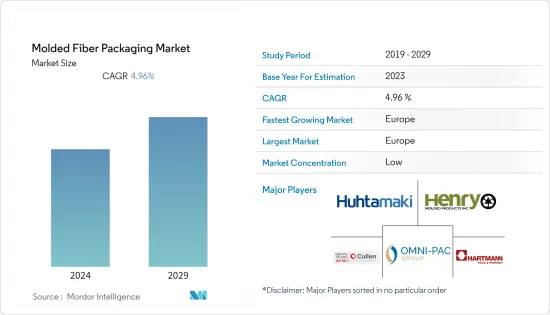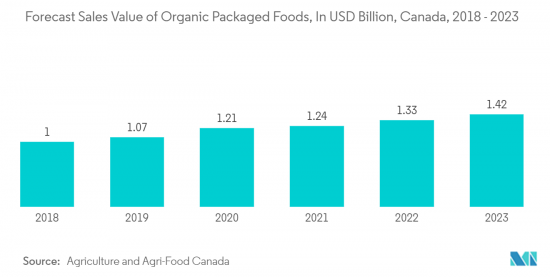PUBLISHER: Mordor Intelligence | PRODUCT CODE: 1405682

PUBLISHER: Mordor Intelligence | PRODUCT CODE: 1405682
Molded Fiber Packaging - Market Share Analysis, Industry Trends & Statistics, Growth Forecasts 2024 - 2029

Molded Fiber Packaging was valued at USD 13.31 billion in the previous year and is expected to reach USD 17.96 billion by the next five years, registering a CAGR of 4.96% during the forecast period.
The growing need for sustainable packaging made from renewable and recyclable materials is leading to continued interest in the potential of molded fiber packaging market. Factors such as expanding demand in end-user industries and applying envir onment-friendly protective packaging solutions are sorting the market. Waste non-wood products like wheat and bagasse are used more frequently to make pulp.
Key Highlights
- Consumers are now more aware of the long-term effects of their purchasing decisions than they were a decade ago. In terms of where and how to spend their money, modern consumers give their purchases careful consideration. This awareness is mostly focused on package sustainability in the modern period as environmental concerns increase. Over 83% of younger consumers (aged 44 and under) have indicated a willingness to spend more for items that employ sustainable packaging, according to Trivium Packaging's Global Buying Green recent report.
- PulPac developed and owned Dry Molded Fiber, a fiber-forming technology that can affordably and sustainably replace single-use plastic with fiber-based alternatives. Converters who set up their production can use this unique technique. PulPac created the PulPac Modula standardized machine platform with partners to hasten the transition. This platform is now accessible to licensees and is available at the PulPac Tech Centre for sample and bridge volume production. To align with global sustainability, quality, and productivity Scandicore, a key manufacturer of sustainability packaging, introduced the first paper tube lids ever produced using PulPac's ground-breaking dry molded fiber technology in February 2022. This spring, the first art print supplies with the revised cover will reach customers. PulPac will produce the bridge volumes.
- Also, molded pulp packaging has been a popular option for organizations wanting to reduce their environmental impact as the packaging sector has come under greater scrutiny in recent years. Pulp-based packaging, made from fibrous materials like recycled cardboard and paper or natural fibers like bamboo, wheat, or sugarcane, is highly recyclable and can be used up to seven more times after serving its initial function. Additionally, molded pulp is biodegradable, as opposed to typical plastic-based packaging, allowing for a reduction in the number of raw materials used to make packaging items.
- However, fluctuations in the cost of raw materials might hinder market growth. However, total fiber availability is a concern in the paper industry. Imports have climbed to three million tons, and numerous nations' governments have adopted import laws and restrictions and increased tariffs and excise levies. Due to a container shortage in December, international liners raised their prices.
- The pandemic presented challenges for the molded pulp packaging market in the short term, but its long-term prospects were positive as it emphasized on hygiene, sustainability, along with the growing demand for essential products. Manufacturers are adjusting to the changing market conditions and working to address supply chain disruptions to meet the rising demand for molded pulp packaging solutions.
- However, post-COVID-19, consumer behavior has changed substantially. Buyers are more concerned than ever before about products' hygiene, disability, and sustainability. The shoppers' evolving needs and a consumer-focused approach will remain crucial as this crisis continues. As the market adapts more to the current scenario, consumer behavior will undoubtedly change in the forecast period. Thus, the post-COVID future for molded fiber packaging looks favorable in terms of demand.
Molded Fiber Packaging Market Trends
Food and Beverages to be the Largest End-user Industry
- Molded fiber products are increasingly used in the food-related sector to replace plastics and meet the growing demand for eco-friendly and sustainable products. Applications for the food market are subject to strict standards and must comply with them. In addition to some basic strength specifications, such as tensile and thermal qualities, improved barrier properties are crucial for materials in the food market sector.
- The food packaging products made of molded pulp include clam-shell and takeout meal containers, egg trays and cartons, and fruit, vegetable, berry, and mushroom trays. The majority of the food packaging items on the market utilize trays.
- Further, the packaging must have barrier qualities that reduce the exchanges of gases and water vapor between the food and the environment to slow down food's chemical, physical, and microbiological changes. As a result, for materials intended for food-related product packaging, the permeability to water vapor and oxygen are crucial properties to consider.
- The relatively big e-commerce, wine, and other beverages segments are expected to see the most significant sales increases in the protective packaging industry. Prices for custom tooling are reducing, and people are becoming more conscious of molded fiber's environmental and performance benefits.
- Soft drink companies are still trying to decrease the amount of pollution and waste produced by their packaging materials. Even though people are becoming more negative towards plastic, it is still the most used material for soft drink packaging worldwide. However, many companies in the molded fiber packaging market are expanding their footprints, boosting the studied segment of the market.
- Further, according to Agriculture and Agri-Food Canada, the sales value of packaged foods in 2018 was valued at USD 1 billion and is expected to reach USD 1.42 billion In 2023. Such growth in the food industry would further drive the market for molded fiber packaging.

Europe is Expected to Dominate the Market
- Western Europe has emerged as one of the most important markets for mold fiber packaging, with industrialized countries such as the United Kingdom having a larger urban population and higher disposable income. The package manufacturing business in the United Kingdom generates GBP 11 billion (USD 13.99 billion) in yearly sales, according to the Packaging Federation of the United Kingdom. It employs over 85,000 people, accounting for 3% of the manufacturing workforce in the United Kingdom. It also substantially contributes to the UK economy and is an important link in the packaging supply chain.
- Germany's packaging business is known for its extensive use in the food industry. Consumers seek products that provide convenience, protection, and ease of transportation, which drives demand for various packaging, particularly plastic replacements in food products, particularly dairy food, meat, and prepared meals. Furthermore, strict limits on single-use plastics and high demand for sustainable packaging drive market expansion.
- In Italy, the growing demand for eco-friendly protective packaging in bowls, trays, and other products is anticipated to boost market growth. Molded fiber packaging is a 100% recyclable, environmentally friendly packaging solution made from plant fibers. The raw materials used to manufacture molded fiber packages are pulp, natural fibers, and water. Molded dissolving pulp products are used mainly as packaging solutions in the food industry, which is driving the market currently.
- Spain's growing urbanization, tourism, and e-commerce market are expected to generate demand for the molded fiber packaging industry. The expanding middle class in the emerging economies of Europe, like Spain, is creating demand for protective packaging solutions, such as heavy-duty molded pulp packaging, subsequently driving the market.
- With the rapidly increasing food service business in Eastern European countries, the Eastern European market is expected to grow at the quickest rate over the projection period. Eastern European countries' demand for molded pulp materials for egg, meat, and fruit packaging will likely contribute to market growth.
Molded Fiber Packaging Industry Overview
The molded fiber packaging market is highly fragmented, with the presence of major players like Huhtamaki OYJ, Henry Moulded Products Inc., Omni-Pac Group UK, Cullen Packaging Ltd., and Brodrene Hartmann A/S. Players in the market are adopting strategies such as partnerships and acquisitions to enhance their product offerings and gain sustainable competitive advantage.
In May 2023, Omni-Pac Group UK, a manufacturer of molded fiber packaging solutions, announced the opening of a new site of EUR 8 Million (USD 8.5 Million) and 60,000 square feet, located in the town of Scunthorpe, which will enable the company to increase its production capacity and create more than 100 new employment opportunities over a period of five years.
In December 2022, Cullen announced a customer acquisition. It will soon be supplying a wide range of its SRPs to CakeDecor, the UK's largest manufacturer and supplier of cake decorations. Cullen also manufactures a wide range of products for factory bakeries, fine food manufacturers, handicraft workshops, and leading UK supermarkets, building a reputation for quality.
Additional Benefits:
- The market estimate (ME) sheet in Excel format
- 3 months of analyst support
TABLE OF CONTENTS
1 INTRODUCTION
- 1.1 Study Assumptions and Market Definition
- 1.2 Scope of the Study
2 RESEARCH METHODOLOGY
3 EXECUTIVE SUMMARY
4 MARKET INSIGHTS
- 4.1 Market Overview
- 4.2 Industry Attractiveness - Porter Five Forces Analysis
- 4.2.1 Bargaining Power of Suppliers
- 4.2.2 Bargaining Power of Buyers
- 4.2.3 Threat of New Entrants
- 4.2.4 Threat of Substitute Products
- 4.2.5 Intensity of Competitive Rivalry
- 4.3 Industry Value Chain Analysis
- 4.4 Assessment of the COVID-19 Impact on the Market
- 4.5 Import Export Analysis of Molded Fiber For Listed Countries
- 4.5.1 United States - Import and Export Analysis
- 4.5.2 United Kingdom - Import And Export Analysis
- 4.5.3 France - Import and Export Analysis
- 4.5.4 Germany - Import and Export Analysis
- 4.5.5 Italy - Import and Export Analysis
- 4.5.6 Sapin - Import and Export Analysis
- 4.5.7 China - Import and Export Analysis
- 4.5.8 Japan - Import and Export Analysis
- 4.5.9 India - Import and Export Analysis
- 4.5.10 Brazil - Import and Export Analysis
- 4.5.11 Mexico - Import and Export Analysis
- 4.5.12 United Arab Emirates - Import and Export Analysis
- 4.5.13 Saudi Arabia - Import and Export Analysis
- 4.5.14 South Africa - Import and Export Analysis
5 MARKET DYNAMICS
- 5.1 Market Drivers
- 5.1.1 Shift in Consumer Preferences Toward Recyclable and Eco-friendly Materials
- 5.1.2 Growing Disposable Income
- 5.1.3 Augmented Demand for Reusable and Sustainable Packaging From End Users
- 5.2 Market Challenges
- 5.2.1 Strict Government Rules and Regulations
- 5.2.2 Fluctuations in the Cost of Raw Materials
6 MARKET SEGMENTATION
- 6.1 By Type
- 6.1.1 Thick wall
- 6.1.2 Transfer
- 6.1.3 Thermoformed
- 6.1.4 Processed
- 6.2 By Formal Type
- 6.2.1 Wet
- 6.2.2 Dry
- 6.3 By End-user Industry
- 6.3.1 Food and Beverages
- 6.3.2 Electronics
- 6.3.3 Healthcare
- 6.3.4 Other End-user Industry
- 6.4 By Geography
- 6.4.1 North America
- 6.4.1.1 United States
- 6.4.1.2 Canada
- 6.4.2 Europe
- 6.4.2.1 United Kingdom
- 6.4.2.2 France
- 6.4.2.3 Germany
- 6.4.2.4 Italy
- 6.4.2.5 Spain
- 6.4.2.6 Rest of Europe
- 6.4.3 Asia Pacific
- 6.4.3.1 China
- 6.4.3.2 Japan
- 6.4.3.3 India
- 6.4.3.4 Rest of Asia Pacific
- 6.4.4 Latin America
- 6.4.4.1 Brazil
- 6.4.4.2 Mexico
- 6.4.4.3 Rest of Latin America
- 6.4.5 Middle East and Africa
- 6.4.5.1 United Arab Emirates
- 6.4.5.2 Saudi Arabia
- 6.4.5.3 South Africa
- 6.4.5.4 Rest of Middle East and Africa
- 6.4.1 North America
7 COMPETITIVE LANDSCAPE
- 7.1 Company Profiles
- 7.1.1 Huhtamaki OYJ
- 7.1.2 Henry Moulded Products Inc.
- 7.1.3 Omni-Pac Group UK
- 7.1.4 Cullen Packaging Ltd.
- 7.1.5 Brodrene Hartmann A/S
- 7.1.6 EnviroPAK Corporation
- 7.1.7 Heracles Packaging Company SA
- 7.1.8 Sabert Corporation
- 7.1.9 Keiding Inc.
- 7.1.10 Berkley International
8 INVESTMENT ANALYSIS
9 FUTURE OF THE MARKET




